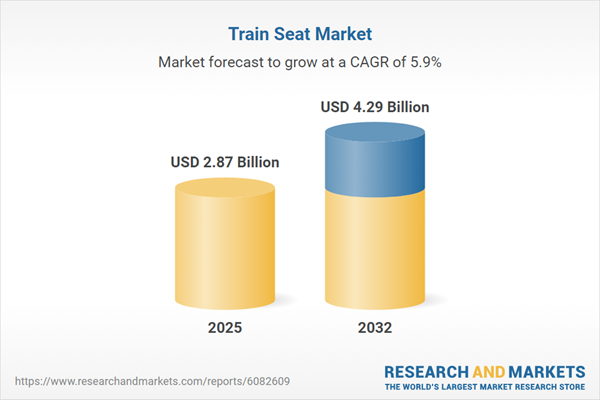Speak directly to the analyst to clarify any post sales queries you may have.
The train seat market is evolving rapidly, driven by higher passenger expectations, increasing sustainability requirements, and the adoption of advanced technologies by rail operators worldwide. Senior decision-makers seeking growth must stay ahead of product trends, regional developments, and strategic innovations.
Market Snapshot: Train Seat Market Size and Growth
The train seat market expanded from USD 2.72 billion in 2024 to USD 2.87 billion in 2025, achieving a Compound Annual Growth Rate (CAGR) of 5.86%. The sector is expected to reach USD 4.29 billion by 2032, reflecting an environment of robust market activity. This growth is powered by investments in passenger comfort, efficiency, and rail modernization. Progress in safety and quality standards is further accelerating strategic procurement across diverse geographies and fleet types.
Scope & Segmentation
- Seat Types: Includes business, economy, first class, and sleeper variants. These options cater to evolving passenger segments and flexible journey needs.
- Materials: Offers fabric, leather, and synthetic seat finishes. Choices balance durability, aesthetics, and regulatory safety demands to suit regional operator preferences.
- Mechanisms: Features fixed seating for high-density routes, manual and automatic reclining, and rotating seats to address flexible interior layouts.
- Installations: Covers solutions for both retrofitting aging fleets and OEM seat installations in new rolling stock, meeting the varied procurement strategies of global operators.
- Price Ranges: Spans budget, standard, and premium pricing segments, enabling alignment with operators’ targeted service levels and cost frameworks.
- Regions: Encompasses Americas (North and Latin America), Europe, Middle East & Africa, and Asia-Pacific (including China, India, Japan, and Australia), each with unique growth and certification drivers.
- Notable Players: Features Grammer AG, Brodie Seating Limited, Fainsa Movilidad S.L., MMT Grupp Oy, INOAC Corporation, SK Sitze GmbH, Shanghai Haoji Seating Co., Ltd., Adient plc, Lear Corporation, and Faurecia SE, which collectively ensure resilient supply chain coverage worldwide.
- Technology Trends: Includes the deployment of smart sensors for seat monitoring, use of lightweight composites, advanced cushioning, digital seat tracking, and modular architectures adaptable to changing operational or regulatory needs.
Key Takeaways for Train Seat Market Leadership
- Innovation in passenger-centric products is essential, guiding procurement toward materials and features that improve comfort and usability for new installations and fleet upgrades.
- Smart technology integration, such as embedded entertainment, real-time diagnostics, and data-driven maintenance, allows operators to differentiate services and optimize operational costs.
- Sustainability commitments are influencing supply chain choices, with recycled inputs and eco-efficient manufacturing gaining traction among sector leaders.
- Differences in regional approaches—from infrastructure spending in the Americas to stringent certifications in Europe, the Middle East, and Africa, and rapid technology adoption in Asia-Pacific—impact purchasing priorities and timelines.
- Collaboration among manufacturers, technology providers, and local partners supports the rapid development of compliant, comfortable, and accessible seating solutions.
- Targeted segmentation by seat type, mechanism, or material supports agile resource allocation and product alignment with operator or regulatory requirements.
Tariff Impact and Strategic Adaptation
Recent United States tariffs enacted in 2025 have prompted industry shifts in supply chain management. Companies are focusing on local assembly and nearshoring to reduce the impact of tariff-driven costs. Enhanced logistics strategies and onshore inventory planning are in use, while advanced materials science and lean manufacturing support product quality and supply chain resilience against cost pressures.
Methodology & Data Sources
This train seat market assessment employs structured interviews with industry stakeholders, detailed analysis of trade journals and patent applications, and validation via government records. The research applies data triangulation by comparing shipment statistics, procurement activities, and certification data to support accuracy and reliability.
Why This Train Seat Market Report Matters
- Supports strategic planning for product development, sustainability programs, and procurement, driving effective long-term operations.
- Delivers practical intelligence for leaders responding to changing regulations, customer expectations, and evolving market conditions, enabling focused risk management.
- Offers competitive benchmarking insights and highlights innovative solutions shaping the future of rail seating across all major regions.
Conclusion
The train seat market will continue to advance as technology, customer needs, and regulation open new growth opportunities. Leaders who act on these insights can enhance service differentiation and operational performance.
Table of Contents
3. Executive Summary
4. Market Overview
7. Cumulative Impact of Artificial Intelligence 2025
Companies Mentioned
The companies profiled in this Train Seat market report include:- Grammer AG
- Brodie Seating Limited
- Fainsa Movilidad, S.L.
- MMT Grupp Oy
- INOAC Corporation
- SK Sitze GmbH
- Shanghai Haoji Seating Co., Ltd.
- Adient plc
- Lear Corporation
- Faurecia SE
Table Information
| Report Attribute | Details |
|---|---|
| No. of Pages | 195 |
| Published | October 2025 |
| Forecast Period | 2025 - 2032 |
| Estimated Market Value ( USD | $ 2.87 Billion |
| Forecasted Market Value ( USD | $ 4.29 Billion |
| Compound Annual Growth Rate | 5.8% |
| Regions Covered | Global |
| No. of Companies Mentioned | 11 |









